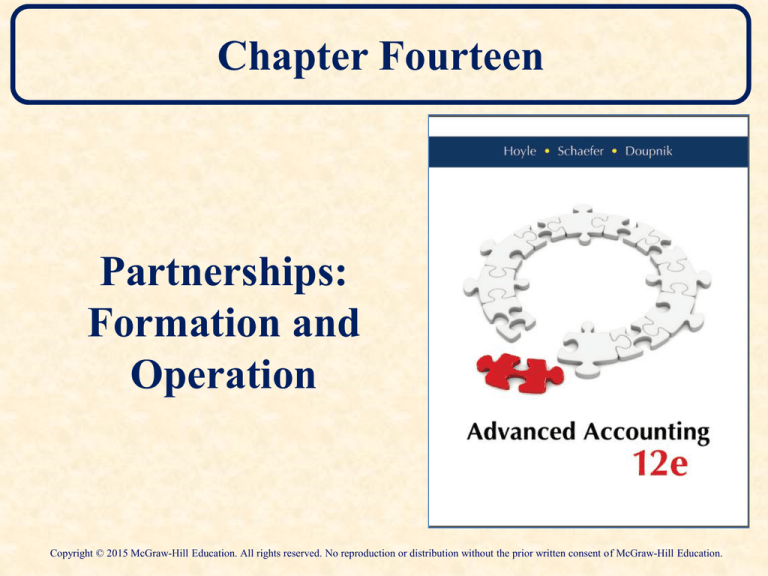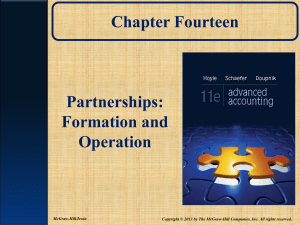
Chapter Fourteen
Partnerships:
Formation and
Operation
Copyright © 2015 McGraw-Hill Education. All rights reserved. No reproduction or distribution without the prior written consent of McGraw-Hill Education.
Partnerships
A partnership is defined as “an association of
two or more persons to carry on a business as
co-owners for profit.” (Section 6 of Uniform
Partnership Act).
The IRS projects that by 2016, nearly 4.7
million partnership U.S. income tax returns
will be filed, compared to 8.1 million
corporation income tax returns. (Source:
www.irs.gov)
14-2
Learning Objective 14-1
Explain the advantages and
disadvantages of the partnership
versus the corporate form
of business.
14-3
Partnership Advantages
Advantages:
Flexibility in defining relationships
Profits and losses, and management operating decisions,
shared independent of ownership percentages.
Ease of formation and dissolution.
Taxes “flow-through” to the partners.
Disadvantages:
Unlimited liability incurred by each partner (they are
“jointly and severally” liable).
Mutual agency (each partner has right to incur liabilities
in the name of the partnership).
Inability to participate in various corporate tax benefits
14-4
Alternative Legal Forms Subchapter S Corporation
Legal characteristics of a corporation.
Ownership limited to 100 stockholders.
Owners limited to individuals, estates, and
certain tax-exempt entities and trusts (no
corporate owners allowed).
Profit passes to owners as a partnership.
14-5
Alternative Legal Forms
Limited Partnership (LP)
Limited partners not allowed to participate in management.
Losses are restricted for limited partners to the amount
invested.
Must have one or more general partners who assume
responsibility for all obligations.
Limited Liability Partnership (LLP)
Owners:
Risk their own investments.
Are responsible for contractual debts of the business.
Are liable only for their own acts and omissions, and
those of individuals they directly supervise.
14-6
Alternative Legal Forms – Limited
Liability Company (LLC)
LLC’s are a new type of organization for U.S.
They have long been used in Europe and other
areas.
They are classified as partnerships for tax
purposes.
In contrast to Sub Chapter S Corporations,
the number of owners is not usually restricted.
Owners only risk their own investments.
14-7
Partnerships Capital Accounts
The equity section of a partnership consists of
capital balances for each partner.
Profits/losses for each period are allocated to
each partner’s capital account.
Withdrawals by partners reduce their capital
accounts.
14-8
Learning Objective 14-2
Describe the purpose of the
articles of partnership and list
specific items that should be
included in this agreement.
14-9
Articles of Partnership
The Uniform Partnership Act establishes standards and
rules for partnerships but a written agreement will
supersede the UPA standards.
Articles of partnership should always clearly describe the:
• Name and address of each partner.
• Business location.
• Nature of the business.
• Rights and responsibilities of each partner.
• Initial contribution to be made by each partner and the
method to be used for valuation.
14-10
Articles of Partnership
Articles of partnership should always clearly describe the:
• Specific method by which profits and losses are to be
allocated.
• Periodic withdrawal of assets by each partner.
• Procedure for admitting new partners.
• Method for arbitrating partnership disputes.
• Life insurance provisions enabling remaining partners to
acquire the interest of any deceased partner.
• Method for settling a partner’s share in the business
upon withdrawal, retirement, or death.
14-11
Learning Objective 14-3
Prepare the journal entry
to record the initial capital
investment made by a partner.
14-12
Accounting for Capital Contributions
Assume that Carter and Green form a business to be
operated as a partnership. Carter contributes
$50,000 in cash and Green invests $20,000. The initial
journal entry to record the creation of the partnership:
14-13
Accounting for Capital Contributions
If one or more of the partners transfers noncash assets,
fair value is used to record the assets. Assume that
Carter invests $50,000 in cash to begin the previously
discussed partnership and Green contributes the
following assets
14-14
Accounting for Capital Contributions
Green’s building is encumbered by a $23,600 mortgage that
the partnership has agreed to assume. Green’s net
investment is equal to $43,400 ($67,000 less $23,600). The
following journal entry records the formation of the
partnership created by these contributions
14-15
Learning Objective 14-4
Use both the bonus method
and the goodwill method
to record a partner’s capital
investment.
14-16
Accounting for Capital Contributions
Contributed intangible assets require special
consideration .
Contributions made by one or more of the
partners may go beyond assets and liabilities,
for example, a particular line of expertise or
established clientele.
Use either the Bonus Method or Goodwill
Method for recording contributed intangible
assets.
14-17
Intangible Contributions Example
James and Joyce open an advertising agency and
organize as a partnership.
James contributes cash of $70,000, and Joyce invests
only $10,000. Joyce, however, is an accomplished
graphic artist, a skill that is considered especially
valuable to this business.
James and Joyce have contributed a total of $80,000
in identifiable assets to their partnership and have
decided on equal capital balances.
14-18
Intangible Contributions Bonus Method Example
The bonus method simply splits the $80,000 capital
evenly between the two partners. Joyce received a capital
bonus of $30,000 (the $40,000 recorded capital balance
in excess of the $10,000 cash contribution) from James in
recognition of her artistic abilities she contributed.
14-19
Intangible Contributions Goodwill Method Example
The goodwill method is based on the assumption that
an implied value can be calculated mathematically
and recorded for any intangible contribution made by
a partner.
In the present illustration, Joyce invested $10,000
cash, $60,000 less than James, but receives an equal
amount of capital according to the partnership
agreement.
14-20
Intangible Contributions Goodwill Method Example
Joyce’s artistic talent has an apparent value of
$60,000, a figure that should be included as part of
this partner’s capital investment. If not recorded,
Joyce’s primary contribution to the business is
ignored completely within the accounting records.
14-21
Learning Objective 14-5
Demonstrate the impact that
the allocation of partnership
income has on the partners’
individual capital balances.
14-22
Allocation of Income
Partnership revenues and expenses must be closed
out at the end of each fiscal period and the net income
allocated to each partners’ capital account.
A method must be devised for assignment of income.
Articles of partnership should stipulate an established
procedure.
If no arrangement is specified, state partnership laws
dictate that all partners receive an equal allocation of
income or loss.
14-23
Allocation of Income -Example
Assume that Tinker, Evers, and Chance form a
partnership by investing cash of $120,000, $90,000, and
$75,000, respectively.
Evers will be allotted 40 % of all profits and losses
because of previous business experience. Tinker and
Chance are to divide the remaining 60 % equally. This
agreement also stipulates that each partner is allowed to
withdraw $10,000 in cash annually from the business.
Net income for the period is $60,000.
14-24
Allocation of Income
Example
14-25
Learning Objective 14-6
Allocate income to partners
when interest and/or salary
factors are included.
14-26
Allocation of Income
Items to be allocated:
Interest on
beginning capital
balances
Allocated
compensation
Bonuses
The allocation of
income is not
necessarily based on
the relative capital
balances.
It is a separately
negotiated item.
Remaining
income
14-27
Alternative Technique-1
Assume the original facts for the Tinkers, Evers, and
Chance partnership except an articles of partnership
agreement credits each partner annually for interest
equal to 10 % of that partner’s beginning capital
balance for the year.
Evers and Chance will also be allotted $15,000 each as a
compensation allowance in recognition of their
participation in daily operations.
Any remaining profit or loss will be split 4:3:3, with the
largest share going to Evers because of the work
experience that this partner brings to the business.
14-28
Alternative Technique- 1
14-29
Alternative TechniquesThe assignment process is merely a series of mechanical
steps reflecting the change in each partner’s capital
balance resulting from the provisions of the partnership
agreement.
The number of different allocation procedures that
could be employed is limited solely by the partners’
imagination.
Although interest, compensation allowances, and
various ratios are the predominant factors encountered
in practice, numerous other possibilities exist.
14-30
Learning Objective 14-7
Explain the meaning of
partnership dissolution and
understand that a dissolution
will often have little or no effect
on the operations of the
partnership business.
14-31
Legal Dissolution
Any alteration in the specific individuals composing a
partnership results in “legal dissolution”
– Departures
– Retirement
– Death
– Admission (including promotion) of a New Partner
– Immediate formation of a new partnership as
business continues
– New partner acquires partnership interest by:
Purchasing it from the other partners, or
making a contribution to the partnership.
14-32
Learning Objective 14-8
Prepare journal entries to
record the acquisition by a
new partner of either all or a
portion of a current partner’s
interest.
14-33
Admission of a New Partner The Rights of a Partner
An individual partner’s
ownership rights include:
The right to co-ownership
in the business property.
The right to share in
profits and losses as
specified in the
partnership agreement
The right to participate in
the management of the
business.
These two rights
can be sold (unless
restricted by the
articles of
partnership).
This right cannot
be sold without the
other partners’
approval.
14-34
Admission of a New Partner Purchase of a Current Interest
A new partner can purchase partnership
interest directly from the existing partners.
The cash goes to the partners, not the
partnership.
Two methods are available to account for the
transfer of ownership:
Book Value Approach
Goodwill (Revaluation) Approach
14-35
Admission of a New Partner Purchase of a Current Interest
Assume Scott, Thompson, and York formed a
partnership, and subsequently, York decides to leave the
partnership. He offers to sell his interest to Morgan.
Although York may transfer the right of property
ownership as well as the specified share of future profits
and losses, the partnership does not automatically admit
Morgan.
York legally remains a partner until such time as both
Scott and Thompson agree to allow Morgan to
participate in the management of the business.
14-36
Admission of a New Partner
Purchase of a Current Interest
Book Value Approach
Instead of York selling his interest to Morgan, each of these
three partners elects to transfer a 20 percent interest to
Morgan for a total payment of $30,000 in a simple capital
reclassification. The money is paid directly to the owners.
14-37
Admission of a New Partner - Purchase
of a Current Interest
Goodwill Approach
Scott, Thompson, and York is transferring all assets and liabilities
to the partnership of Scott, Thompson, York, and Morgan. The
goodwill method recognizes the transaction as occurring between
two separate reporting entities that necessitates the complete
revaluation of all assets and liabilities.
14-38
Learning Objective 14-9
Prepare journal entries to
record a new partner’s admission
by a contribution made directly to
the partnership.
14-39
Admission of a New Partner Contribution to the Partnership
The new partner can also gain
partnership interest by contributing
cash to the partnership.
Remember that the new cash will
increase the partnership’s net assets.
Two methods are:
Bonus Approach
Goodwill Approach
14-40
Admission of a New Partner Contribution to the Partnership
An outsider may be admitted to a partnership by
contributing directly to the business. Assume King and
Wilson maintain a partnership and presently report
capital balances of $80,000 and $20,000, respectively.
According to the articles of partnership, King is entitled
to 60 % of all profits and losses with the remaining 40%
credited each year to Wilson. Goldman can enter the
partnership for $20,000 cash with the money going into
the business. Goldman receives an initial 10 percent
interest in partnership property.
14-41
Admission of a New Partner Contribution to the Partnership
Bonus Credited to Original Partners
Goodwill Credited to Original Partners
14-42
Admission of a New Partner Contribution to the Partnership
Hybrid Method
14-43
Admission of a New Partner Contribution to the Partnership
Bonus or Goodwill Credited to New Partner
14-44
Learning Objective 14-10
Prepare journal entries to
record the withdrawal of a
current partner.
14-45
Withdrawal of a Partner
The Withdrawing Partner is paid out in accordance
with the Partnership Agreement.
Using the Bonus Method, any amount paid in excess of
that partner’s capital account is allocated against the
remaining partners’ capital accounts.
Using the Goodwill Method, the books are first
adjusted to FMV, with a proportion of the increase
allocated to each partner’s account. The withdrawing
partner is then paid based on the balance in the
individual capital account.
14-46
Withdrawal of a Partner
Bonus Method Applied
Goodwill Method Applied
14-47
Withdrawal of a Partner
Hybrid Method Applied
14-48





